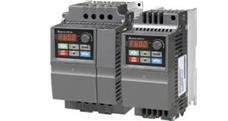What are the control methods of Delta inverter?
< p=""> 1. Voltage space vector (SVPWM) control method:
Delta inverter is based on the premise of the three-phase waveform overall generation effect, aiming at the ideal circular rotating magnetic field trajectory of the motor air gap. A three-phase modulation waveform is generated at a time, and the inner-cut polygon is forced to approach the circle. After practice, it has been improved, that is, the introduction of frequency compensation can eliminate the error of speed control; by the reaction budget flux linkage amplitude, eliminate the influence of stator resistance at low speed; close the output voltage and current to improve the dynamic accuracy and Stability. However, there are many control circuit links, and there is no adjustment of the introduced torque, so the system function has not been improved.
2. Vector control (VC) method:
The vector control of variable frequency speed regulation is to pass the stator currents Ia, Ib, Ic of the asynchronous motor in the three-phase coordinate system. The three-phase-two-phase change is equivalent to the communication current Ia1Ib1 in the two-phase stop coordinate system, and then the rotation is changed according to the rotor field orientation, equivalent to the direct current Im1, It1 in the synchronous rotating coordinate system (Im1 is equivalent to the DC motor) The excitation current; It1 is equivalent to the armature current proportional to the torque), and then according to the control method of the DC motor, the control amount of the DC motor is obtained, and the control of the asynchronous motor is completed by the corresponding coordinate reverse conversion. The essence is that the communication motor is equivalent to a DC motor, and the two components of speed and magnetic field are independently controlled. By manipulating the rotor flux linkage and then decomposing the stator current, the two components of the torque and the magnetic field are obtained, and the coordinates are changed to complete the orthogonal or decoupling manipulation. The introduction of vector manipulation methods has epoch-making significance. However, in practical applications, because the rotor flux linkage is difficult to accurately observe, the system characteristics are greatly affected by the motor parameters, and the vector rotation used in the equivalent DC motor control process is more disorderly, making the practical control effect difficult to achieve the ideal analysis. result.
3, Direct Torque Control (DTC) method:
In 1985, Professor DePenbrock of Ruhr University in Germany first proposed the direct torque control frequency conversion skills. This skill largely solves the lack of vector manipulation mentioned above, and has been rapidly developed with novel manipulation thinking, simple and clear architecture, and excellent dynamic and static functions. Now, this skill has been successfully applied to high-power communication drives for electric locomotive traction. Direct torque control directly analyzes the mathematical model of the communication motor in the stator coordinate system, and manipulates the flux linkage and torque of the motor. It does not require the communication motor to be equivalent to a DC motor, thus eliminating many of the clutter calculations in the vector rotation change; it does not need to be modeled after the DC motor, nor does it need to simplify the mathematical model of the communication motor for decoupling.
4, matrix type AC-AC control method:
VVVF frequency conversion, vector control frequency conversion, direct torque control frequency conversion are all one of AC-DC-AC frequency conversion. The common defect is that the input power factor is low, the harmonic current is large, the DC circuit needs a large storage capacitor, and the regenerative energy cannot be reflected back to the grid, that is, the four-quadrant operation cannot be performed. To this end, matrix-type AC-AC frequency conversion came into being. Because the matrix type AC-AC frequency conversion eliminates the intermediate DC link, it saves the bulky and expensive electrolytic capacitor. It can complete a power factor of l, the input current is sinusoidal and can operate in four quadrants, and the power density of the system is large. Although this skill is not sophisticated now, it still attracts many scholars to study in depth. The essence is not to indirectly manipulate the current, flux linkage, etc., but to directly calculate the torque as the manipulated amount. The specific method is:
1. Control the stator flux linkage to introduce the stator flux linkage observer to complete the speed sensorless method;
2. Automatic identification (ID) relies on accurate mathematical model of the motor Automatic identification of motor parameters;
3, calculate the practical value corresponding to the stator impedance, mutual inductance, magnetic saturation elements, inertia, etc. to calculate the actual torque, stator flux, rotor speed for real-time control;
4. Complete the Band-Band control. The PWM signal is generated by the Band-Band control of the flux linkage and torque to control the inverter switch state.
Matrix AC-AC has fast torque response, high speed accuracy and high torque accuracy; together with high starting torque and high torque accuracy, especially at low speeds (including 0 speed), can output 150% ~ 200% torque.


